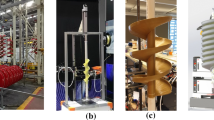Abstract
The paper discusses the principles of controlling the parameters of a functional voxel model during the manufacturing of a part prototype using additive technologies. A way to build a functional voxel model based on the mapping of local geometry features is considered. An approach is offered to supporting structures modeling, which employs gradient motion in the space of functional voxel models based on the solidification principle.











Similar content being viewed by others
Notes
STL—file format widely used for storing three-dimensional object models for use in additive technologies. Information about an object is stored as a list of triangular faces that describe its surface and their normals. The STL file can be text (ASCII) or binary. Its name comes from the abbreviation of the term “Stereolithography,” because it was originally used in this technology of three-dimensional printing.
Triangulation in its most general sense is the partition of a geometric object into simplexes. For example, on a plane it is a division into triangles, which is where this name comes from.
Slicing is the process of converting a 3D model into a control code for a 3D printer. The model is cut (sliced) in layers. Each layer consists of a perimeter and/or fill. The model may have different fill percentages, and there may also be no fill (hollow pattern). Each layer (slice) moves along the XY axis with the application of the plastic melt. After printing one layer, the Z-axis moves one layer higher, the next layer is printed, etc.
Support—a system of supporting structures.
Voxel is a three-dimensional image element containing the value of a raster element in three-dimensional space. Voxels are analogues of two-dimensional pixels for three-dimensional space.
Normal is a straight line perpendicular to the tangent space.
Gradient is a vector that, by its direction, indicates the direction of the greatest increase of a certain quantity, the value of which changes from one point in space to another (scalar field), and in magnitude (modulus) is equal to the growth rate of this quantity in this direction. Gradient descent is a method of finding the local extremum (minimum or maximum) of a function by moving along the gradient.
A cubic spline is a smooth function, the domain of which is divided into a finite number of segments, on each of which it coincides with some cubic polynomial.
De Casteljau’s algorithm is a recursive method to evaluate polynomials in Bernstein form or Bezier curves. This algorithm can also be used to split a single Bezier curve into two Bezier curves at an arbitrary parameter value.
Polygonal (flat) models (grids)—surfaces of geometric objects in the form of a set of flat polygons connected to each other. The traditional computer graphics description of a polygonal model of an object is hierarchical and includes a list of vertices, a list of edges and a list of polygons of the object.
REFERENCES
Tolok, A.V., Funktsional’no-voksel’nyi metod v komp’yuternom modelirovanii (Functional Voxel Method in Computer Modeling), Moscow: Fizmatlit, 2016.
Grigoryev, S.N., Tolok, N.B., and Tolok, A.V., Local search gradient algorithm based on functional voxel modeling, Program. Computer Software, 2017, vol. 43, no. 5, pp. 300–306.
Rvachev, V.L., Tolok, A.V., Uvarov, R.A., and Sheiko, T.I., New apparoaches to generating equations of the three-dimensional loci using R-functions, Biolog. Nauki, Visn. Zaporizh. Derzh. Univ.: Zbirn. Nauk. St., 2000, no. 2, pp. 119–131.
Maksimenko-Sheiko, K.V., Tolok, A.V., and Sheiko, T.I., R-functions in analytical design using the “RANOK” system, Vestn. Mosk. Gos. Tekhnol. Univ. “Stankin”, 2010, no. 4(12), pp. 139–151.
Maksimenko-Sheiko, K.V., Matsevityi, A.M., Tolok, A.V., and Sheiko, T.I., R-functions and reverse problem of analytical geometry in 3D space, Novye Tekhnol., 2007, no. 10, pp. 23–32.
Maksimenko-Sheiko, K.V., Tolok, A.V., and Sheiko, T.I., R-functions and analytical description of geometric objects with symmetry, Novye Tekhnol., 2009, no. 7, pp. 57–62.
Tolok, A.V., Maksimenko-Sheiko, K.V., Sheiko, T.I., and Litvinova, Yu.S., Analytical identification of machine-building parts with R-functions, Inform. Tekhnol. Proekt. Proizv., 2016, no. 1, pp. 38–43.
Tolok, A.V. and Tolok, N.B., Mathematical programming problems solving by functional voxel method, Autom. Remote Control, 2018, vol. 79, no. 9, pp. 1703–1712.
Tolok, A.V., Tolok, N.B., and Loktev, M.A., Modeling function domain for curves constructed based on a linear combination of basis Bernstein polynomials, Program. Computer Software, 2018, vol. 44, no. 6, pp. 526–532.
Batuev, E.R. and Tolok, A.V., Study of the process of modeling support structures based on functional voxel models for additive technologies, Proc. 17th Int. Conf. CAD/CAM/PDM (Moscow, 2017), pp. 158–160.
Batuev, E.R. and Tolok, A.V., Functional-Voxel Method for Constructing Support Structures for Additive Technologies, Proc. 18th Int. Conf. CAD/CAM/PDM (Moscow, 2018), pp. 97–101.
Author information
Authors and Affiliations
Corresponding authors
Additional information
Translated by V. Potapchouck
Rights and permissions
About this article
Cite this article
Tolok, A.V., Tolok, N.B. & Batuev, E.R. Voxel Modeling of the Control of Prototype Manufacturing with Additive Technologies. Autom Remote Control 82, 506–515 (2021). https://doi.org/10.1134/S0005117921030103
Received:
Revised:
Accepted:
Published:
Issue Date:
DOI: https://doi.org/10.1134/S0005117921030103




